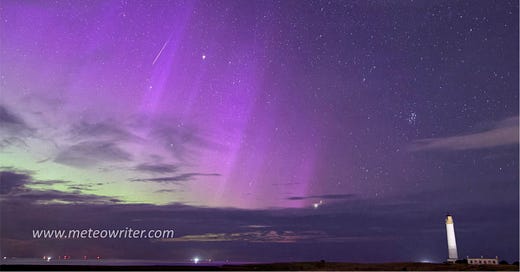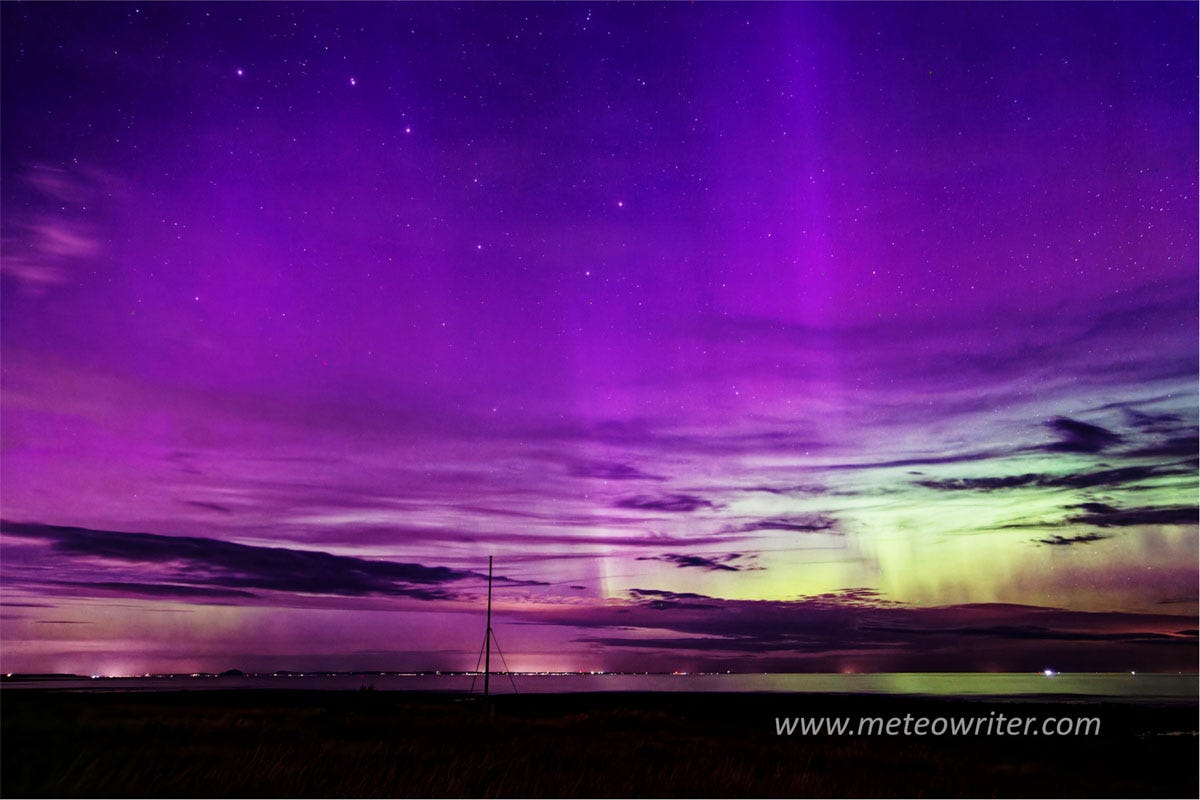Meteors are often called nature’s fireworks and the Perseids give one of the finest displays of the year, with the advantage of occurring in August rather than the depths of winter.
This year, the peak was due on the night of 12/13 August, but as with all meteor showers it’s worth considering going out a few days before or after if conditions don’t look great on the day. Unusually, though, this time there was a run of clear nights, with the added prospect of a major geomagnetic storm giving the chance - unusual for August - of seeing the Northern Lights.
Watching developments over the weekend, I decided to wait for the night of the peak, hopeful that the Northern Lights would appear again as they had on the previous night. And they certainly did, with a pink-suffused pillar rising up almost overhead on arriving at my chosen viewpoint, and a large area of light on the horizon. I had planned to travel on to a darker spot, but on seeing the faint flash of a meteor decided to stay, hopefully getting the best of both worlds.
A view of the Northern Lights at around midnight through patchy cloud, with the Big Dipper (Plough) constellation alongside
Meteors occur when minute particles enter the atmosphere, emitting light as they burn up before reaching the ground. Sporadic meteors occur all year but more intense showers happen when the Earth passes through the debris left by an asteroid or comet. The Perseids result from Comet Swift-Tuttle, which was discovered in 1862 by Lewis Swift and Horace Tuttle and won’t return to our solar system for more than a century.
With meteor showers, the strength of the display depends on several factors, including the speed, density and mineral composition of the debris, plus of course the amount of ambient light. The best of the display is often after midnight, once the Earth rotates around sufficiently that your location is travelling toward the cloud of debris. ‘Cloud’ here is something of an exaggeration as each particle may be separated by thousands of kilometres!
For the Perseids, the Earth takes more than five weeks to travel through the comet’s debris, but the highest meteor rates occur within a period of just a few days, closest to the comet’s orbital path. Peak rates can be more than a hundred an hour and average speeds are about 60 km/s, or a very respectable 135,000 mph.
On that night, after an hour or so I began to wonder if the Northern Lights would be the main sight, but things began to improve from around 1am. As expected, most meteors were fast moving, and I stopped counting at twelve but saw several more, including some bright flashes. There was the added benefit of the Milky Way too, visible high overhead. Unusually, only four meteors appeared on camera, although pleasingly two were against the backdrop of the Northern Lights.
The Northern Lights and a Perseid meteor about 95 minutes after the first photograph
For the future, this trip slightly changed my ideas about just how dark a site you need to see meteors, as my chosen spot had lights on the horizon and the Northern Lights increased the amount of light around. There are several ways to classify light pollution of which the Bortle Scale - devised by John Bortle, an American astronomer - is perhaps the most widely used by amateur astronomers, as follows:
Class 1 - Excellent dark-sky site
Class 2 - Typical truly dark site
Class 3 - Rural sky
Class 4 – Rural/suburban transition
Class 5 – Suburban sky
Class 6 – Bright suburban sky
Class 7 – Suburban/urban transition
Class 8 – City sky
Class 9 – Inner city sky
If you search online, you can find websites that will give an idea of the amount of light pollution in your area; for example, lightpollutionmap.info suggests that I live in a Class 6 area and my Perseid viewing spot was Class 4. Some advice from NASA says:
For most of us, getting to a Bortle-class 3 or 4 location is dark enough for a great evening of stargazing. To get to darker sites generally requires long drives to remote spots, but it can be worth it! There are a variety of websites and apps that provide maps of light pollution and Bortle ratings.
There are many other factors at play, though, such as the phase of the moon, how high up you are (think clear mountain air), the extent (if any) of cloud cover, and how long you allow for your eyes to adjust to the darkness. Perhaps the best meteor sightings I’ve had were in the high deserts of the western USA, which I now know were Class 1-2, so maybe searching for a site that dark is one to try next time!
Further reading
Spectacular Britain, Kevin Sene, Bloomsbury, 2024, for more insights into viewing and photographing meteors and the Northern Lights, and the science behind them Link
And a tidal bore postscript
Tidal bores are another of nature’s wonders and I recently did a guest post about them for the Outdoor Writers and Photographers Guild (OWPG), of which I’m a member, who have a very fine Substack site. The post describes how I first got interested in tidal bores and some of the science behind them and you can read it here:








As opposed to blue suburban skies, which are found above Penny Lane Liverpool.
You did well to see them around the NE. I've looked a few times but either too much cloud or light pollution. Super photos :)))